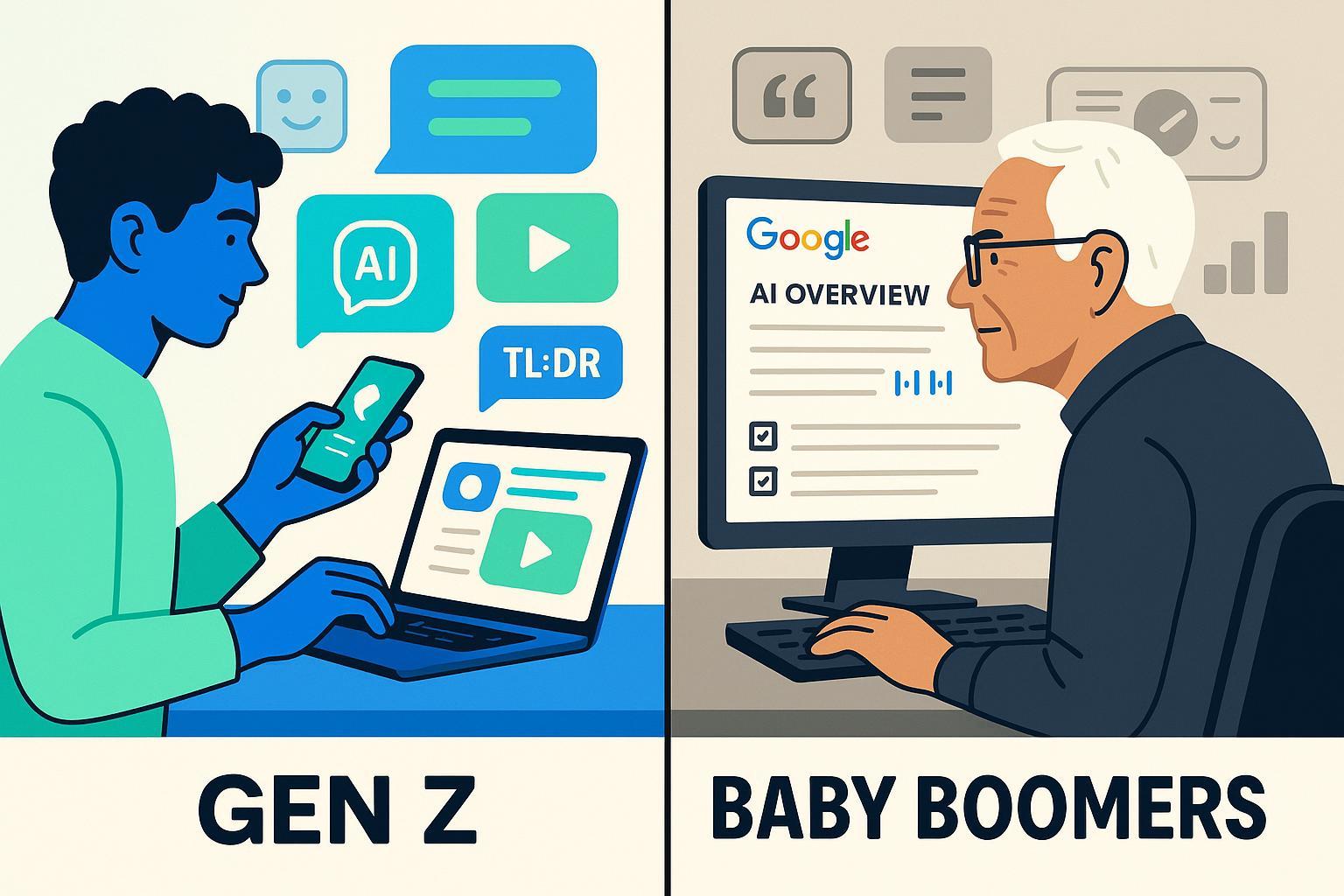Gen Z vs Baby Boomers in AI Search (2025): Comparison & Content Customization
Gen Z vs Baby Boomers: AI search adoption, behavioral differences, and actionable 2025 content and channel strategies. Compare traits, customize for each cohort, and optimize brand visibility in ChatGPT, Perplexity, Google AI Overview.


Executive summary
AI search is changing how people discover and evaluate information, but not everyone uses it the same way. In 2025, Gen Z shows high-frequency, conversational AI usage across ChatGPT-style chats and emerging engines like Perplexity, while Baby Boomers are adopting more cautiously, often via Google’s AI Overviews embedded in familiar search results. Marketers who tailor content, verification, and CTAs by cohort can lift both visibility inside AI answers and downstream conversions.
What this means for you:
- Prioritize concise, chunkable answers and TL;DRs for Gen Z, backed by transparent citations they can drill into.
- For Boomers, emphasize credibility, step-by-step clarity, and easy verification paths (recognizable authorities, phone/chat support, printable resources).
- Monitor brand visibility and sentiment inside AI answers across platforms; iterate based on what each cohort actually sees and trusts.
What the latest data says (with 2025 context)
- Younger cohorts are leading AI search adoption. A February 2025 survey summarized by Search Engine Land reports that 82% of Gen Z respondents had used AI search tools at least occasionally versus 45% of Boomers, with 14% using AI tools daily in that sample, highlighting the gap in familiarity and frequency (Search Engine Land, Higher Visibility survey, 2025).
- Broader consumer AI usage continues to rise. Menlo Ventures’ 2025 “The State of Consumer AI” notes 61% of U.S. adults used AI in the past six months and 19% use AI daily, with younger cohorts over-indexing on daily use compared to Boomers (Menlo Ventures — The State of Consumer AI (2025)).
- Gen Z is increasingly turning to AI chatbots for search. PYMNTS’ July 2025 analysis indicates strong Gen Z usage of AI chatbots for discovery and tasks, while a much larger share of Boomers reported no chatbot use in their sample, underscoring a wider adoption gap (PYMNTS — Gen Z turning to AI chatbots for search (2025)).
- AI exposure within Google is rising via AI Overviews. Desktop trigger rates reached about 13% of U.S. queries by March 2025, mainly informational—meaning both cohorts increasingly encounter AI summaries even if they don’t visit standalone chatbots (Search Engine Land — AI Overviews in ~13% of searches (Mar 2025)).
- AI search impact on traffic is real but still small. Generative AI referral traffic grew fast into 2025 but remains around 1% of organic traffic; still, inclusion in AI Overviews correlates with higher click share compared to exclusion, so visibility matters (Search Engine Land — GenAI referrals ~1.24% (2025) and Search Engine Land — AI Overviews hurt/help CTR depending on inclusion (2025)).
- Trust and use cases diverge. SurveyMonkey/Momentive’s February 2025 generational snapshot shows Gen Z is more likely to use AI for learning (61%) and is generally more comfortable with AI recommendations than Boomers, who prefer verifiable sources and traditional channels (SurveyMonkey/Momentive — Generational AI trends (2025)).
Note on uncertainty: Study methodologies vary; treat figures as directional and watch the dates in citations.
How behaviors differ (side‑by‑side)
- Adoption & frequency
- Gen Z: High adoption; frequent use across school, work, and personal tasks; quick to try new tools (e.g., Perplexity, Claude).
- Boomers: Moderate adoption; use AI as a supplement to traditional search; lower daily frequency.
- Trust & verification
- Gen Z: Higher baseline comfort; wants transparent sources and the option to dive deeper.
- Boomers: Lower default trust; seek recognizable authorities (associations, .gov/.edu) and easy-to-verify citations.
- Query style & tasks
- Gen Z: Conversational, longer prompts; brainstorming, comparisons, study aids; expects multimodal (text + video/images).
- Boomers: Direct, task-focused questions; practical how‑tos, product/service info, local/health/finance basics.
- Device & context
- Gen Z: Mobile-first plus desktop; social-to-AI discovery loops; in‑app AI assistants.
- Boomers: Heavier desktop/laptop; email/newsletters; bookmarked resources; voice assistants for utility.
- Content format preferences
- Gen Z: TL;DR summaries + deep dives; short videos, carousels, interactive tools; comparison matrices.
- Boomers: Clear headings, scannable text, step‑by‑step guides, printable checklists; larger type and high contrast.
- Proof & authority signals
- Gen Z: Peer/community proof; transparent methods; side-by-side evidence.
- Boomers: Institutional credibility, expert quotes, certifications, third‑party reviews.
- Conversion triggers
- Gen Z: Free trials/freemium, creator codes, student discounts, fast onboarding.
- Boomers: Phone/chat support, demos, guarantees, accessibility assurances.
Two practical playbooks for 2025
Playbook A — Designing for Gen Z AI searchers
- Formats and structure
- TL;DR box at the top answering the exact question in 3–5 bullets; link to sources directly under it.
- Visual-first modules: short explainer videos, annotated screenshots, interactive calculators, comparison tables.
- Provide copy‑pasteable prompt bundles for ChatGPT/Perplexity.
- Voice and messaging
- Conversational, transparent, slightly playful; show your work (methods, dates, limits).
- Include peer proof: creator testimonials, community reviews, ratings.
- Technical setup for AI surfaces
- Use descriptive H2/H3s that mirror natural‑language questions; add FAQ and HowTo schema where relevant.
- Keep content fresh; include last‑updated dates. Ensure citations are explicit with canonical sources.
- For Perplexity, favor well‑structured, comprehensive pages with concise summaries and clear references, aligning to its emphasis on recency and authority as described in its help docs (Perplexity — How it works, 2025).
- CTA patterns
- Trials/freemium or interactive demos first; highlight student pricing if offered. Fast sign‑up; SSO if possible.
Playbook B — Designing for Baby Boomer AI searchers
- Formats and structure
- Plain‑language, step‑by‑step guides with numbered headings; include printable PDFs and checklists.
- Prominent contact options (phone/chat/email) and service guarantees.
- Voice and messaging
- Calm, authoritative, empathetic; lead with benefits, safety, and support.
- Use expert quotes and recognizable authorities; link to .gov/.edu or professional associations where appropriate.
- Technical setup for AI surfaces
- Clear, descriptive headings; scannable paragraphs; glossary for domain terms.
- Accessibility-forward: larger base font, high contrast, captions/transcripts.
- For Google AI Overviews, cover informational intent comprehensively and align with top organic content since AO citations overlap heavily with top results by late 2024 (Search Engine Land — 99% overlap by Aug 2024).
- CTA patterns
- Invite to schedule a demo or call; reaffirm privacy, security, and human support.
Verification and accessibility checklists
Verification architecture (for both cohorts, with different emphases)
- Always-on source transparency: cite original studies and official docs; include publication year in copy.
- Methods/limitations mini‑section on key pages; date stamps and update logs.
- External authority linking:
- Gen Z: include methodology cards and peer/community reviews.
- Boomers: link to recognized authorities (.gov/.edu, associations), expert quotes, certifications.
- Chunkable answers for AI: concise summaries; structured lists; explicit definitions; FAQ and HowTo schema.
- Monitor AI answers for accuracy and sentiment; correct misattributions quickly.
Accessibility essentials for 2025 (WCAG 2.2‑aligned)
- Text: base 16–18px, line height ~1.5; clear type hierarchy; avoid walls of text.
- Contrast: meet 4.5:1 (normal) and 3:1 (large) minimums; target 7:1 for older users when feasible (W3C WCAG 2.2, 2023).
- Media: captions/transcripts; alt text; keyboard navigation support; touch targets ≥44×44px.
- Plain language: 6th–8th grade reading level for consumer pages; glossary for jargon.
Measurement and experimentation: make AI visibility a managed channel
- Segmentation and attribution
- Use UTM parameters for likely AI-sourced links (e.g., utm_source=chatgpt/perplexity/google_ai_overview).
- Where analytics permits, segment conversions by age cohort; otherwise infer via channel/creative and on-site behavior.
- Track CTR from AI summaries, dwell time on TL;DR vs deep dives, verification link clicks, conversion split (trial/freemium vs demo/call), and support contact rate.
- Similarweb’s April 2025 release shows growing ability to isolate AI chatbot referrals, helping triangulate volumes (Similarweb — AI Chatbot Traffic launch, 2025).
- Experiment design
- Test tone (playful vs authoritative), evidence density, CTA type, and video vs static modules.
- For Perplexity/ChatGPT, test prompt bundles and structured comparison tables vs narrative explainers.
Scenario micro-examples
- Topic: “How to choose a password manager”
- Gen Z variant: Start with a TL;DR matrix comparing 5 tools on student pricing, mobile UX, autofill speed, and open‑source status; include a 60‑second video and copy‑pasteable prompts for evaluating privacy policies in ChatGPT.
- Boomer variant: Lead with a plain‑language explainer on what a password manager does, outline safety and data handling, cite a .gov/.edu guide, provide a printable checklist, and a phone number to get help installing.
- Topic page structure for AI Overviews
- Ensure comprehensive coverage of common sub‑questions (definitions, pros/cons, safety, cost, steps) using clear H2/H3s; include a date‑stamped methods/limitations note to build trust and alignment with AO citation behavior documented in 2024–2025 SEL analyses (Search Engine Land — AO guides, 2025).
- Perplexity citation readiness
- Provide a concise summary box, clearly labeled references to primary sources, and recent updates; this aligns with Perplexity’s emphasis on recency, relevance, and authority (Perplexity — Help Center, 2025).
How Geneo helps (without overshadowing the playbooks)
If you’re allocating budget to AI search in 2025, you need to see what AI engines actually say about your brand—and how that differs by audience intent.
- Cross‑platform monitoring: Track brand mentions and citations across ChatGPT, Perplexity, and Google AI Overviews in one place, and spot gaps where competitors are referenced instead (capabilities described on the official site: Geneo — platform overview).
- Sentiment and verification insights: Surface how your brand is framed (positive/neutral/negative) and whether responses contain recognizable authorities or certifications—crucial for Boomers.
- Historical tracking: Log changes in AI answers after content updates and measure the delta in visibility/sentiment over time.
- Prioritized recommendations: Use optimization suggestions to create chunkable TL;DRs, add citations for AO/Perplexity, and tailor CTAs by cohort.
Example workflows
- Gen Z focus: Monitor student‑oriented queries in ChatGPT/Perplexity, identify which prompts yield your brand mention, and craft creator‑friendly assets that AIs tend to cite.
- Boomer focus: Audit AI answers on health/finance/local services to verify authority signals and contact options appear; add missing .gov/.edu citations and support pathways.
Final recommendations by scenario
- Educational/B2C software: Lead with TL;DRs, comparison tables, and prompt bundles for Gen Z; provide a printed quick‑start guide and a support hotline for Boomers.
- Healthcare/finance services: Build robust verification architecture and link to recognized authorities for Boomers; for Gen Z, add transparent methodology and peer/community proof while keeping safety disclaimers prominent.
- Local services: Optimize Google Business Profile and ensure AI‑readable NAP consistency; include step-by-steps and phone options for Boomers; short video explainers and price transparency for Gen Z.
- B2B: Offer quick sandbox trials for Gen Z decision influencers; expert case studies with measurable outcomes and demo scheduling for Boomers.
Ready to see how AI platforms present your brand today? Audit your AI visibility and sentiment across ChatGPT, Perplexity, and Google AI Overviews with Geneo: https://geneo.app. For practical how‑tos, explore guides like How to check ChatGPT citations (2025) and Tracking keyword rankings in Perplexity.

